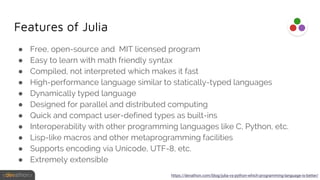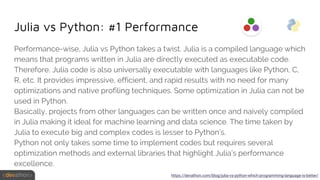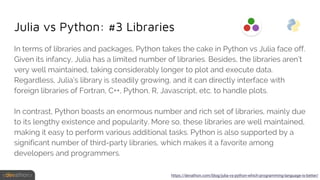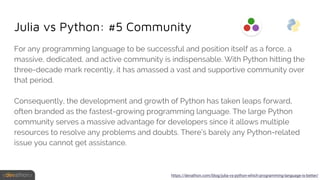Julia vs Python 2020
- 2. Introduction to Python Python is an interpreted, object-oriented, high-level and multi-paradigm programming language with dynamic semantics. The language was created in 1991 by Guido van Rossum as a successor to his previous language ABC. He took all the useful features and syntax of ABC to create a new language; Python. Further, Python is a general-purpose language that features high-level in-built data structures as well as dynamic typing, dynamic binding, and many more features. This makes Python convenient for use in Complex or Rapid Application Development or as a scripting or glue language that connects components. https://devathon.com/blog/julia-vs-python-which-programming-language-is-better/
- 3. Features of Python ● Easy to code and learn ● Free and Open Source with a Python Software Foundation License ● Object-Oriented Language ● Dynamically Typed Language ● GUI Programming Support ● High-Level Language ● Extensible Language ● Portable Language ● Multi-platform Language ● Interpreted Language ● Large Standard Library https://devathon.com/blog/julia-vs-python-which-programming-language-is-better/
- 4. Who uses Python? Over its existence, Python has emerged as a crucial programming language for various companies and startups. Owing to its versatility and simplicity, Python is used and continues to play a vital role in giant companies such Wikipedia, Google, Yahoo!, Dropbox, CERN, NASA, Reddit, Facebook, Amazon, Instagram, Netflix, Spotify, ILM etc. Elsewhere, Python has been successfully embedded in many software products as a scripting language such as 3DS Max, Abaqus etc. Also, Python is used in video games, information security, AI and machine learning projects. Not to mention, it’s frequent use as an intro language into computer sciences courses across the globe. While the list is endless, it gives the idea to Python’s popularity as the language of choice for many companies and institutions. https://devathon.com/blog/julia-vs-python-which-programming-language-is-better/
- 5. Introduction to Julia Founded in 2009 and launched in 2012, Julia is an open-source, high- performance, high-level, and dynamically-typed programming language. As its four creators blatantly say it, Julia was created in the name of greed; to resolve the inadequacies of other programming languages while also integrating the unique and desirable features of the same languages. While initially designed as a general-purpose programming language, Julia greatly thrives at numerical and scientific computing. The language uses multiple dispatches as its central programming paradigm and supports parallelism in three primary levels, namely: Julia coroutines (green threading), multi-threading, and multi-core or distributed processing. https://devathon.com/blog/julia-vs-python-which-programming-language-is-better/
- 6. Features of Julia ● Free, open-source and MIT licensed program ● Easy to learn with math friendly syntax ● Compiled, not interpreted which makes it fast ● High-performance language similar to statically-typed languages ● Dynamically typed language ● Designed for parallel and distributed computing ● Quick and compact user-defined types as built-ins ● Interoperability with other programming languages like C, Python, etc. ● Lisp-like macros and other metaprogramming facilities ● Supports encoding via Unicode, UTF-8, etc. ● Extremely extensible https://devathon.com/blog/julia-vs-python-which-programming-language-is-better/
- 7. Who uses Julia? With Julia being exceptionally fast and high performing, it comes as no surprise that it has drawn the attention of prominent users. Specifically, Julia language is very popular among mathematicians and data scientists. Most notably, the Celeste project, which is a Julia-based project used the language to catalogue telescopic data for all visible astronomical objects. The project became the first Julia-based application to record a 1.54 PF/s (petaflops) peak performance in just 14.6 minutes, setting a new scientific milestone. Other key users of Julia include NVIDIA, CISCO, the Climate Modeling Alliance, Cancer Research UK, QuantEcon, etc. with the list growing. https://devathon.com/blog/julia-vs-python-which-programming-language-is-better/
- 8. Julia vs Python: #1 Performance Performance-wise, Julia vs Python takes a twist. Julia is a compiled language which means that programs written in Julia are directly executed as executable code. Therefore, Julia code is also universally executable with languages like Python, C, R, etc. It provides impressive, efficient, and rapid results with no need for many optimizations and native profiling techniques. Some optimization in Julia can not be used in Python. Basically, projects from other languages can be written once and naively compiled in Julia making it ideal for machine learning and data science. The time taken by Julia to execute big and complex codes is lesser to Python’s. Python not only takes some time to implement codes but requires several optimization methods and external libraries that highlight Julia’s performance excellence. https://devathon.com/blog/julia-vs-python-which-programming-language-is-better/
- 9. Julia vs Python: #2 Speed Speed was one of the main objectives in the creation and development of Julia. The need for a programming language with the speed of C, and for a fact, Julia doesn’t disappoint! Interestingly, Julia is a member of the Petaflop Club which comprises computing languages that surpass a one petaflop per second peak performance. Julia is not interpreted hence uses just-in-time (JIT) compilation and type declarations to execute codes that involve compilation at run time. Julia impresses at complex numerical and computational functions since it is designed to quickly execute codes. Further, its multiple dispatch quickly defines data types like numbers and arrays. In comparison, Python is fast but not as Julia. However, with ongoing speed Python interpreter improvements, Python can be made faster via external libraries, optimization tools and third-party JIT compilers https://devathon.com/blog/julia-vs-python-which-programming-language-is-better/
- 10. Julia vs Python: #3 Libraries In terms of libraries and packages, Python takes the cake in Python vs Julia face off. Given its infancy, Julia has a limited number of libraries. Besides, the libraries aren’t very well maintained, taking considerably longer to plot and execute data. Regardless, Julia’s library is steadily growing, and it can directly interface with foreign libraries of Fortran, C++, Python, R, Javascript, etc. to handle plots. In contrast, Python boasts an enormous number and rich set of libraries, mainly due to its lengthy existence and popularity. More so, these libraries are well maintained, making it easy to perform various additional tasks. Python is also supported by a significant number of third-party libraries, which makes it a favorite among developers and programmers. https://devathon.com/blog/julia-vs-python-which-programming-language-is-better/
- 11. Julia vs Python: #4 Tooling Support Tooling support is an essential aspect of any programming language. Python easily takes the lead over edges Julia. Having a supportive and active programming community, Python brags brilliant tool support, systems, and interfaces built by its community. However, Julia lacks substantial support and many great resources, debugging tools, or resolving issues with a performance like Python does. https://devathon.com/blog/julia-vs-python-which-programming-language-is-better/
- 12. Julia vs Python: #5 Community For any programming language to be successful and position itself as a force, a massive, dedicated, and active community is indispensable. With Python hitting the three-decade mark recently, it has amassed a vast and supportive community over that period. Consequently, the development and growth of Python has taken leaps forward, often branded as the fastest-growing programming language. The large Python community serves a massive advantage for developers since it allows multiple resources to resolve any problems and doubts. There’s barely any Python-related issue you cannot get assistance. https://devathon.com/blog/julia-vs-python-which-programming-language-is-better/
- 13. Conclusion By now, we’re sure you can easily pass judgment on who takes the crown in Julia vs Python’s face-off. Although Julia is attracting some attention and making a name for itself, Python is not falling back in the same race. Whichever language you might opt for, many factors have to be considered since each language has its strengths and drawbacks. Nevertheless, Julia has a long journey ahead should it want to match Python’s footprint in the aforementioned fields. Only with full maturity which might be years away and a mass community following can Julia increase its relevance as a programming language and achieve complete industry adoption. Are you looking to get your App built? Contact us at [email protected] or visit our website Devathon to find out how we can breathe life into your vision with beautiful designs, quality development, and continuous testing.













